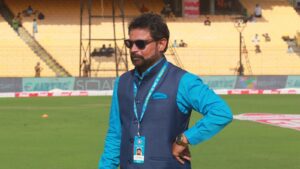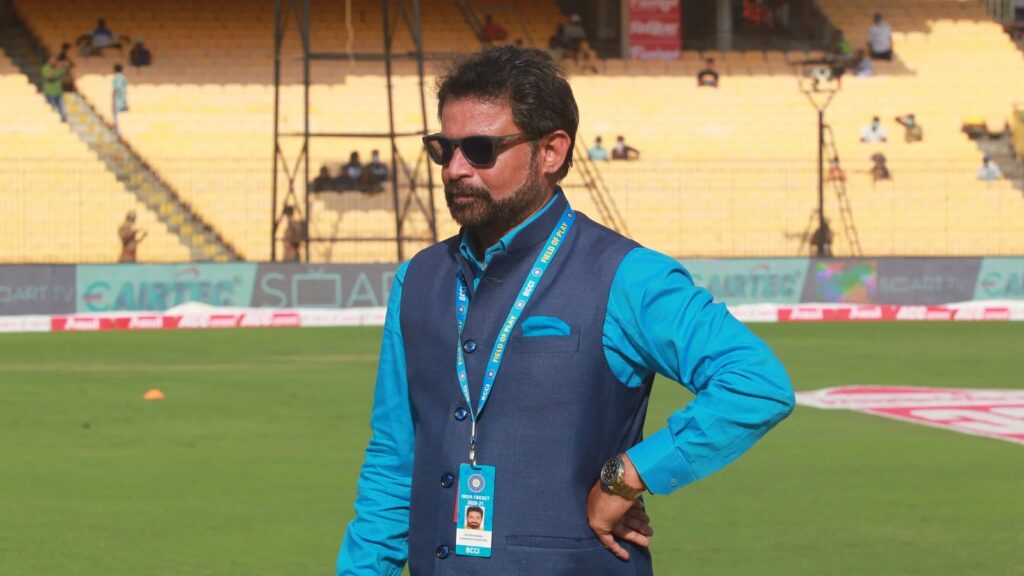
The chief selector’s words weren’t meant for public consumption, and most of what he said was hardly earth-shattering either. But we need to be careful when throwing words like ‘doping’ around.
How is Chetan Sharma remembered in the annals of Indian cricket? Though his Test career was over at the age of 23, he was the first Indian bowler to take a ten-wicket haul in a Test on English soil (1986). With the bat, he was gifted enough to make a Test 50 against Craig McDermott and friends, and smash a 96-ball 101* in a Nehru Cup game against England in 1989. But no matter what else he did, his name has always been associated with THAT last ball to Javed Miandad at Sharjah in 1986. That six defined his career, and it was to his great credit that he responded to the inevitable questions about it with good humour and grace.
Now chairman of the selection panel for the men’s team, Sharma, also a popular commentator in the days following his retirement, is again in the news for all the wrong reasons. But before we address the contents of the sting operation carried out by a TV channel, we should first question the ethics of it. Hidden-camera footage has always been a massive grey area. There’s a case to be made that it’s justified in situations that affect a nation’s sovereignty and security, as well as when it comes to uncovering rampant corruption.
This ‘sting’ doesn’t impact the layperson’s life in any way. It’s not unearthing a national scandal, nor are the revelations of any earth-shattering importance. In fact, if you follow sport, many of the exposes are pretty mundane, hardly worth a second thought.
Before we pile on and put the boot into Sharma – who will almost certainly lose his job after this – pause for a second and consider this. How many of us would be happy if our private conversations, whether face to face, over the phone or by text, were exposed to the world at large? There’s a reason why it’s called ‘private’. Whoever made this video gained Sharma’s confidence and trust, and then betrayed it. It’s hard to find any justification for that.
Was he an idiot to say some of what he did? You could say that. But again, in the compant of friends and others we trust, so many of us let our guard down and say things you wouldn’t want shown on TV or printed on a page. We may be living in an increasingly woke world, but few human beings exercise thought control in their intimate circles. Sharma is being hung out to dry on the basis of things said behind closed doors, or so he thought, and that just isn’t right.
As for the things said, the very fact that some of it is even considered news just betrays how little some know of the nature of sport and the teams that play it. Consider this gem: the Indian team has two camps, one led by Virat Kohli and another by Rohit Sharma. Apparently, they don’t dislike each other, but both have big egos.
News flash. Very few top sportspersons reach the summit without an ego. Sharma played most of his cricket in teams where individuals followed either Kapil Dev or Sunil Gavaskar, two vastly different personalities. Pakistan won a World Cup in 1992 with a team that had the patrician Imran Khan as captain and Javed Miandad, street fighter supreme, as its frontline batsman. When Manchester United won the treble under Sir Alex Ferguson in 1998-99, the relationship between Andy Cole and Teddy Sheringham was so frosty that they barely exchanged a word, on or off the pitch.
A sports team is no magic circle. Just like any other workspace, it has its share of close bonds, animosity, petty jealousy and back-stabbing. This applies especially to the relationship between a boss and his employees. If Sourav Ganguly and Kohli didn’t like each other, so be it. You don’t need to like everyone you work with to push on towards a common goal. Only an utter fraud will claim that they love everyone else, and neither Ganguly nor Kohli is anything but genuine.
The really unsavoury aspect of this sting is the loose talk about ‘doping’. What Sharma and the correspondents who put the video package together know about modern medicine and rehabilitation techniques could be printed on a paper napkin. It simply isn’t a topic that people should be talking about without adequate knowledge, especially when players’ reputations are at stake.
Here are the facts. Each sports team, whether that’s the Indian cricket one or Real Madrid, has a pool of medical doctors at their disposal. These in-house physicians deal with everyday niggles and problems, as well as supervising rehab programs when players return from injury. But we also live in an increasingly specialised world. Since top teams can afford it, a player with a knee injury or a shoulder problem is almost invariably referred to the leading surgeon or specialist in that field.
There was a time a few decades ago when footballers would get their knees operated only by the legendary Richard Steadman, the Colorado-based surgeon who passed away last month. Sachin Tendulkar went to Andrew Wallace, another expert, in London when he needed shoulder surgery in 2006. Legions of footballers went to Hans Mueller-Wohlfahrt in Germany for treatment of persistent hamstring issues.
Many of these sporting injuries require jabs, spaced out over several weeks. That isn’t doping, it’s called treatment. And in almost every such case, the player will get the jab from the specialist rather than the in-house panel of doctors. As for the ‘revelation’ that players often try to play when 80 per cent fit, welcome to the real world. Modern-day sporting schedules are so intense and hectic that if teams were to field only those who were fully fit, there would be no matches.
Living and playing with aches and niggles is part of a sporting life. Had you ever seen Harbhajan Singh’s spinning finger or Tendulkar’s shattered toe during their playing days, you would have winced and turned away in disgust. But those are the sacrifices players make to get back out on the park and win games for their teams. To loosely attribute those recoveries to ‘doping’ is not just disrespectful, but slanderous.
Look too at the irony of this. For years, the media in India has complained about the BCCI’s opacity, of how the board never feels obliged to offer explanations for its actions. In the wake of Kohli’s removal as captain last year, Sharma was one of the few board functionaries willing to go on the record to try and explain the sequence of events. Now that you’ve stitched him up, good luck expecting others to talk.
In a week when Australia cricket was in utter disarray after the three-day thrashing in Nagpur, we have unwittingly given them a major boost with this non-story. Once, when he was asked about that last-ball six, Sharma replied: “That’s cricket, that’s life.” This, though, just isn’t cricket. It’s nonsense.




